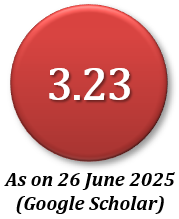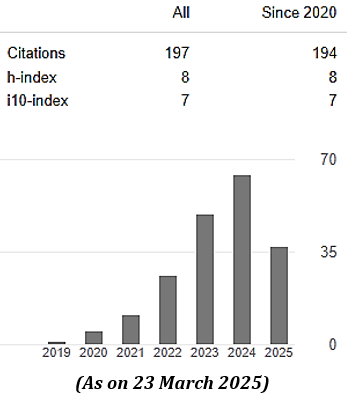Geographical Information System Approach to Delineate the Watershed’s Morphometric Parameters for Sustainable Hydrological Modeling of Barind Region, Bangladesh
Abstract
Water is an important resource of the earth’s surface and it is integral for all on this planet. The availability or the scarcity of water depends on the watershed characterizes that consider the basic, linear, and shape parameters of any waterbody. The objective of the study was to delineate 14 morphometric parameters in the Barind region (Dinajpur district, Bangladesh) for sustainable hydrological modeling. An ASTER-DEM of 30-meter resolution data, geographical information system (GIS), and Remote sensing technique were used for extracting drainage components of interest region. The whole study region was covered by the flow of the Purnovoba river, Jamuna river, Atrai river (part-1 and part-2). Research results found that the Purnovoba river had a high bifurcation ratio (0.9982) that defined hydrologically more disturbed than the other three watershed areas and it had a high stream frequency (0.8332) that denoted rocky having low infiltration capacity. Jamuna river had a low drainage density (0.7322) that defined more vegetation having higher permeability. Besides, the Jamuna river had the lowest no. of stream order that was insignificant in the steady runoff process and less prone to cause a flash flood. The research predicted that the availability of groundwater might decrease to Jamuna river in the future as it had the lowest basin area (217.42 sqr. km ) and perimeter (114.90 km) and the basin surface slope would become gentle to Atrai river part-1 for the lowest length of overland flow (0.6072). Purnovoba river experienced the lowest form factor (0.2351) which indicated the most possibility for erosion. The elongated ratio of all basins was greater than 0.5 which considered all the shapes were more elongated. These findings will help for further modeling of an integrated watershed for sustainable hydrological models in the Barind region.
Downloads
References
Ahmed, S., Chandrashekarappa, K., Raj, S., Nischitha, V., & Kavitha, G. (2010). Evaluation of morphometric parameters derived from ASTER and SRTM DEM—a study on Bandihole sub-watershed basin in Karnataka. Indian society of remote sensing, 38(2), 227-238.
Ahn, S.-R., & Kim, S.-J. (2019). Assessment of watershed health, vulnerability and resilience for determining protection and restoration Priorities. Environmental Modelling & Software, 122, 103926.
Al-Assadi, K. H. F. (2020). Analyzing the morphometric characteristics of Wadi Mezal basin using geographical information systems. Groundwater for Sustainable Development, 100436.
Alam, A., Ahmed, B., & Sammonds, P. (2020). Flash flood susceptibility assessment using the parameters of drainage basin morphometry in SE Bangladesh. Quaternary International.
Alnahit, A. O., Mishra, A. K., & Khan, A. A. (2020). Quantifying climate, streamflow, and watershed control on water quality across Southeastern US watersheds. Science of The Total Environment, 139945.
Altaf, F., Meraj, G., & Romshoo, S. A. (2013). Morphometric analysis to infer hydrological behaviour of Lidder watershed, Western Himalaya, India. Geography Journal, 2013.
Ameri, A. A., Pourghasemi, H. R., & Cerda, A. (2018). Erodibility prioritization of sub-watersheds using morphometric parameters analysis and its mapping: A comparison among TOPSIS, VIKOR, SAW, and CF multi-criteria decision making models. Science of the Total Environment, 613, 1385-1400.
Amiri, M., Pourghasemi, H. R., Arabameri, A., Vazirzadeh, A., Yousefi, H., & Kafaei, S. (2019). Prioritization of flood inundation of Maharloo Watershed in iran using morphometric parameters analysis and TOPSIS MCDM model. In Spatial modeling in GIS and R for earth and environmental sciences (pp. 371-390): Elsevier.
Balasubramanian, A., Duraisamy, K., Thirumalaisamy, S., Krishnaraj, S., & Yatheendradasan, R. K. (2017). Prioritization of subwatersheds based on quantitative morphometric analysis in lower Bhavani basin, Tamil Nadu, India using DEM and GIS techniques. Arabian Journal of Geosciences, 10(24), 552.
Banerjee, A., Singh, P., & Pratap, K. (2017). Morphometric evaluation of Swarnrekha watershed, Madhya Pradesh, India: an integrated GIS-based approach. Applied Water Science, 7(4), 1807-1815.
Chandniha, S. K., & Kansal, M. L. (2017). Prioritization of sub-watersheds based on morphometric analysis using geospatial technique in Piperiya watershed, India. Applied Water Science, 7(1), 329-338.
Charizopoulos, N., Mourtzios, P., Psilovikos, T., Psilovikos, A., & Karamoutsou, L. (2019). Morphometric analysis of the drainage network of Samos Island (northern Aegean Sea): Insights into tectonic control and flood hazards. Comptes Rendus Geoscience, 351(5), 375-383.
Chatterjee, S., Krishna, A., & Sharma, A. (2014). Geospatial assessment of soil erosion vulnerability at watershed level in some sections of the Upper Subarnarekha river basin, Jharkhand, India. Environmental earth sciences, 71(1), 357-374.
Choudhari, P., Nigam, G. K., Singh, S. K., & Thakur, S. (2018). Morphometric based prioritization of watershed for groundwater potential of Mula river basin, Maharashtra, India. Geology, Ecology, and Landscapes, 2(4), 256-267.
Dragičević, N., Karleuša, B., & Ožanić, N. (2018). Improvement of Drainage Density Parameter Estimation within Erosion Potential Method. Paper presented at the Multidisciplinary Digital Publishing Institute Proceedings.
Du, H., Dou, S., Deng, X., Xue, X., & Wang, T. (2016). Assessment of wind and water erosion risk in the watershed of the Ningxia-Inner Mongolia Reach of the Yellow River, China. Ecological Indicators, 67, 117-131.
Elsadek, W. M., Ibrahim, M. G., & Mahmod, W. E. (2019). Runoff hazard analysis of Wadi Qena Watershed, Egypt based on GIS and remote sensing approach. Alexandria Engineering Journal, 58(1), 377-385.
Ervinia, A., Huang, J., Huang, Y., & Lin, J. (2019). Coupled effects of climate variability and land use pattern on surface water quality: An elasticity perspective and watershed health indicators. Science of The Total Environment, 693, 133592.
Fu, X., Hopton, M. E., Wang, X., Goddard, H., & Liu, H. (2019). A runoff trading system to meet watershed-level stormwater reduction goals with parcel-level green infrastructure installation. Science of The Total Environment, 689, 1149-1159.
Gajbhiye, S., Mishra, S., & Pandey, A. (2014). Prioritizing erosion-prone area through morphometric analysis: an RS and GIS perspective. Applied Water Science, 4(1), 51-61.
Ghorbani Nejad, S., Falah, F., Daneshfar, M., Haghizadeh, A., & Rahmati, O. (2017). Delineation of groundwater potential zones using remote sensing and GIS-based data-driven models. Geocarto international, 32(2), 167-187.
Gong, J., & Xie, J. (2009). Extraction of drainage networks from large terrain datasets using high throughput computing. Computers & Geosciences, 35(2), 337-346.
Harmel, R., Cooper, R., Slade, R., Haney, R., & Arnold, J. (2006). Cumulative uncertainty in measured streamflow and water quality data for small watersheds. Transactions of the ASABE, 49(3), 689-701.
Harsha, J., Ravikumar, A., & Shivakumar, B. (2020). Evaluation of morphometric parameters and hypsometric curve of Arkavathy river basin using RS and GIS techniques. Applied Water Science, 10(3), 1-15.
Horton, R. E. (1945). Erosional development of streams and their drainage basins; hydrophysical approach to quantitative morphology. Geological society of America bulletin, 56(3), 275-370.
Javed, A., Khanday, M. Y., & Rais, S. (2011). Watershed prioritization using morphometric and land use/land cover parameters: a remote sensing and GIS based approach. Geological Society of India, 78(1), 63.
Liu, B.-W., Wang, M.-H., Chen, T.-L., Tseng, P.-C., Sun, Y., Chiang, A., & Chiang, P.-C. (2020). Establishment and Implementation of Green Infrastructure Practice for Healthy Watershed Management: Challenges and Perspectives. Water-Energy Nexus.
Liu, K., Song, C., Ke, L., Jiang, L., & Ma, R. (2020). Automatic watershed delineation in the Tibetan endorheic basin: A lake-oriented approach based on digital elevation models. Geomorphology, 107127.
Metz, M., Mitasova, H., & Harmon, R. (2011). Efficient extraction of drainage networks from massive, radar-based elevation models with least cost path search. Retrieved from
Mokarram, M., & Hojati, M. (2017). Morphometric analysis of stream as one of resources for agricultural lands irrigation using high spatial resolution of digital elevation model (DEM). Computers and Electronics in Agriculture, 142, 190-200.
Okumura, M., & Araujo, A. G. (2014). Long-term cultural stability in hunter–gatherers: a case study using traditional and geometric morphometric analysis of lithic stemmed bifacial points from Southern Brazil. Archaeological Science, 45, 59-71.
Panhalkar, S., Mali, S., & Pawar, C. (2012). Morphometric analysis and watershed development prioritization of Hiranyakeshi Basin in Maharashtra, India. International journal of environmental sciences, 3(1), 525-534.
Patel, D. P., Dholakia, M. B., Naresh, N., & Srivastava, P. K. (2012). Water harvesting structure positioning by using geo-visualization concept and prioritization of mini-watersheds through morphometric analysis in the Lower Tapi Basin. Indian society of remote sensing, 40(2), 299-312.
Pondari, S., Dandabathula, G., Bera, A., Nagamani, P., & Amminedu, E. (2020). Characterization of drainage network of Brahmaputra river basin in Indian sub-continent using geospatial technologies. Science, Technology and Environment Informatics, 8(01), 583-594.
Poongodi, R., & Venkateswaran, S. (2018). Prioritization of the micro-watersheds through morphometric analysis in the Vasishta Sub Basin of the Vellar River, Tamil Nadu using ASTER Digital Elevation Model (DEM) data. Data in brief, 20, 1353-1359.
Prasannakumar, V., Vijith, H., & Geetha, N. (2013). Terrain evaluation through the assessment of geomorphometric parameters using DEM and GIS: case study of two major sub-watersheds in Attapady, South India. Arabian Journal of Geosciences, 6(4), 1141-1151.
Rashid, M. B., Islam, M. B., & Sultan-Ul-Islam, M. (2013). Causes of acute water scarcity in the Barind Tract, Bangladesh. Economic and Environment Geology, 4(1), 5-14.
Ratnam, K. N., Srivastava, Y., Rao, V. V., Amminedu, E., & Murthy, K. (2005). Check dam positioning by prioritization of micro-watersheds using SYI model and morphometric analysis—remote sensing and GIS perspective. Indian society of remote sensing, 33(1), 25.
Rong, Q., Cai, Y., Su, M., Yue, W., Yang, Z., & Dang, Z. (2019). A simulation-based bi-level multi-objective programming model for watershed water quality management under interval and stochastic uncertainties. Environmental Management, 245, 418-431.
Saha, A., Joseph, J., & Ghosh, S. (2020). Climate controls on the terrestrial water balance: Influence of aridity on the basin characteristics parameter in the Budyko framework. Science of The Total Environment, 139863.
Schumm, S. A. (1956). Evolution of drainage systems and slopes in badlands at Perth Amboy, New Jersey. Geological society of America bulletin, 67(5), 597-646.
Senter, A. E., Pasternack, G. B., Piegay, H., Vaughan, M. C., & Lehyan, J. S. (2017). Wood export varies among decadal, annual, seasonal, and daily scale hydrologic regimes in a large, Mediterranean climate, mountain river watershed. Geomorphology, 276, 164-179.
Soni, S. (2017). Assessment of morphometric characteristics of Chakrar watershed in Madhya Pradesh India using geospatial technique. Applied Water Science, 7(5), 2089-2102.
Sreedevi, P., Owais, S., Khan, H., & Ahmed, S. (2009). Morphometric analysis of a watershed of South India using SRTM data and GIS. Geological Society of India, 73(4), 543-552.
Strahler, A. N. (1964). Handbook of applied hydrology. Quantitative geomorphology of drainage basins and channel networks. New York, NY: Mc-Graw Hill Book Company, 39-76.
Sujatha, E. R., Selvakumar, R., & Rajasimman, B. (2014). Watershed prioritization of Palar sub-watershed based on the morphometric and land use analysis. Mountain Science, 11(4), 906-916.
Suresh, M., Sudhakar, S., Tiwari, K., & Chowdary, V. (2004). Prioritization of watersheds using morphometric parameters and assessment of surface water potential using remote sensing. Indian society of remote sensing, 32(3), 249-259.
Tykocki, T., du Plessis, J., & Wynne-Jones, G. (2018). Analysis of morphometric parameters in cervical canal stenosis on neutral and dynamic magnetic resonance imaging. World neurosurgery, 114, e317-e322.
Wada, C. A., Pongkijvorasin, S., & Burnett, K. M. (2020). Mountain-to-sea ecological-resource management: Forested watersheds, coastal aquifers, and groundwater dependent ecosystems. Resource and Energy Economics, 59, 101146.
Withanage, N., Dayawansa, N., & De Silva, R. (2014). Morphometric analysis of the Gal Oya river basin using spatial data derived from GIS. Tropical Agricultural Research, 26(1), 175-188.
MIJST follows the open access policy.

This work is licensed under a Creative Commons Attribution-NonCommercial 4.0 International License. This allows anyone to copy, share, distribute, and modify the work for non-commercial purposes, where the original work and source should be properly credited.
















